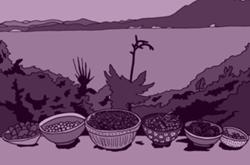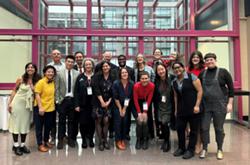
Something hit home as the New Year dawned with three months to go on our 100-Mile Diet. Not a resolution so much as a realization: Hey, this isn't about us anymore. Alisa and I are just two more fellow-travelers in an expanding spectrum of people who've taken hold of the local-eating concept and gone out to do their own thing.
Our therapist, if we had one, would want to know how we feel about this loss of control. And the answer would be, "Groovy."
North of 55 degrees latitude and 1,100 kilometers away by road, for example, Shannon Askew and Judy April took inspiration as the fall harvest came to an end. An outreach worker and a dietician, respectively, Askew and April organized a 100-Mile meal for the Baby's Best Chance single mothers' program in Chetwynd, a town of 3,100 people in the southwest corner of Peace River Country.
They started with a simple, if somewhat loaded, question: "Can we eat well in Chetwynd without buying chemically-altered foods picked and packaged three weeks ago by exploited migrant farm workers and marketed by giant international corporations for huge profits?"
Some of the Chetwynd moms had other concerns, as well. They worried about getting complete nutrition from local foods; some wondered if the meal would be possible at all. "So we made lunch," says Askew, "and it was pretty easy."
A full plate
The final menu was 13 items long and tells its own story of life in a place where everyone knows everybody else. A hunter donated elk meat for burgers. The eggs came from "Mrs. Warnke, Lone Prairie." Johnnie supplied the baby potatoes and Howard the onions (from his garden at Stu's place). Judy picked the Saskatoon berries from behind the hospital.
But it wasn't all homespun charm. The meal was equally a lesson in social studies and economics. Two of the lunch ingredients, canola oil and milk, come from local producers-but travel hundreds of miles to be processed. "This whole area, they grow wheat, canola, oats, barley, rye and it's all shipped out. There's nothing that gets milled right here," says Askew. She remembers when there was a dairy factory in nearby Dawson Creek, but it was bought up by a larger corporation and shut down.
So there was quite a bit on the Chetwynd moms' plates that afternoon, literally and metaphorically. Askew, meanwhile, hopes to try another 100-Mile meal, this time for the folks at the town hall. Her goal is an eventual municipal food plan to look at everything from the canned-or-frozen meals being dished at the local hospital, to the way communities are losing jobs to the "efficiency" of centralized food production, and onward to community garden access for the "apartment moms" for whom affordable dining means pre-made pizza and Kraft Dinner.
The question comes up again and again in the interviews Alisa and I now regularly field about the 100-Mile Diet: sure, you can do this in warm-and-wet Vancouver, but what about farther north, or places where the winter hits hard? I have a new answer. Askew actually felt sorry for us as we try to get by without the riches of northern B.C. (especially the grains-but see the latest news from that front, below).
Welcome to Bemidji
Even bolder proof comes from another new crew of local eaters, this time out of Bemidji, Minnesota, a town of 15,000 souls a few hours' drive southeast of Winnipeg.
Out there, they know a little something about winter. I recently met a woman who had homesteaded in the area; come the cold season, she said, they would spray down the north side of the house to create an ice barrier against the wind. Yet in September, seven people linked to the White Earth Tribal College began a year of local eating. They've chosen to draw on a 250-mile radius, and each is allowed a dozen "trade items"-long-distance products like curry powder, salt and chocolate-but they're also relying heavily on wild plants to get by. Sounds brutal, yes, but the Minnesota group is lacking in…practically nothing.
"We're not going to run out of food," says Sunny Johnson, one of the project organizers and an instructor of native-plant classes. "Here we are fat and happy."
In fact, there is much to envy. The Minnesota group is smack in the middle of the grain belt, and even has access to crystal sugar from sugar beets. They've tapped maples and bought wild rice; they've made acorn flour and dried leafy vegetables like plantain, wood sorrel and chickweed. Milkweed is a favourite wild plant, with spring shoots like asparagus, flower heads like broccoli and pods that contain a cheese alternative. With wild ginger and star sarsaparilla root, Johnson hopes to ferment a kind of soda. "I really hope it works. I want a fizzy drink."
Johnson is also running an "economic impact" study of the experiment, comparing the average American's $91-per-week food budget to the price of local eating. "I've paid $66 per week," she says. "We're trying to break down the fallacy that local eating is more expensive."
More and more experiments
Do we need any more proof that local eating is much more an adventure than it is a hair-shirt exercise in environmental do-goodliness? The list of experiments goes on, from San Francisco's 100-mile-eating "Locavores" group to a crew in Santa Barbara, California, who are working toward a 100-Mile food label for local producers. Here in Vancouver, Alisa and I were finally able to eat on the town without fudging our own self-imposed rules. Already a pioneer in regional cooking, Raincity Grill and its chef de cuisine Andrea Carlson will launch a 100-Mile Tasting Menu to follow on Valentine's Day. We were graciously invited to a test drive; for the moment, suffice it to say that my mashed fava beans on mashed potatoes seems less inspiring after taste sensations like epazote-cured Agassiz Coho roe and "Castle Blue" cheese soufflé.
We've heard from Australia, Norway, France…and then, on Thanksgiving Day, two friends planted the 100-Mile Diet seed in Powell River. The result has been a 100-Mile Flurry of Activity. Well, not exactly 100-Mile-these people want to stay really close to home, and one possible plan would draw food and drink from between Saltery Bay and Sarah Point (a linear distance of not even 40 miles). "We have everything we need, I think, in this local area-if we get the timing right," says Kathie Mack, who is helping to spearhead the experiment. The Powell River group is aiming for six weeks of local eating, most likely beginning in August or September. Why six weeks? "Because six weeks forms a habit."
Reaction from the area's farmers was initially muted, says Mack-the old-timers have seen their fair share of west coast idealists. After a few meetings and a few shared meals, though, the farmers are asking the local-eating group what they want grown for next year.
"We don't have a lot of industry in Powell River," says Mack. "We have the paper mill, but they've laid a lot of people off. We're really interested in keeping our young people in the community, and you know what? A lot of them are really interested in farming and raising food.
"For me, this is the next step," she adds. "We did the organics thing, but I am appalled at how far organic food sometimes has traveled and, you know, what does it taste like when it's come that far and been picked that long ago?"
Chew on this
But wait a minute-what about, ahem, us? What have Alisa and I been up to while the expanding 100-Mile community is busy saving the world? Well, let's see now…uh, mostly we've been eating. In December, we became the proud owners of 75 pounds of unbelievably fresh and delicious west coast wheat flour, as grown and milled by Highland Farms in North Saanich on Vancouver Island. We have since feasted on bread, crackers, pies, whole-wheat noodles and, dipping into the 25 pounds of unsifted, whole-bran flour that Highland Farms' Hamish Fraser calls "the real thing," the finest pancakes we've ever eaten.
It came at just the right time. When I spoke to Shannon Askew in Chetwynd, I had to admit that I was still eating meals of potatoes, potatoes and more potatoes. She had this to say: "There're all these stories that used to come out of Ireland about, you know, five people sitting around a table eating maybe five potatoes. The idea was to chew the potatoes very slowly and imagine they were something else."
That's the best thing about having new friends and allies. You get some really good ideas.
In last month's column, J.B. and Alisa announced they had reached a book deal with Harmony in New York. The latest: Random House will be publishing their 100-Mile Diet book in Canada. For more information on finding locally produced food visit the web site of Farm Folk/City Folk.
Read the whole 100-Mile Diet Series. ![]()
Read more: Local Economy
















Tyee Commenting Guidelines
Comments that violate guidelines risk being deleted, and violations may result in a temporary or permanent user ban. Maintain the spirit of good conversation to stay in the discussion.
*Please note The Tyee is not a forum for spreading misinformation about COVID-19, denying its existence or minimizing its risk to public health.
Do:
Do not: